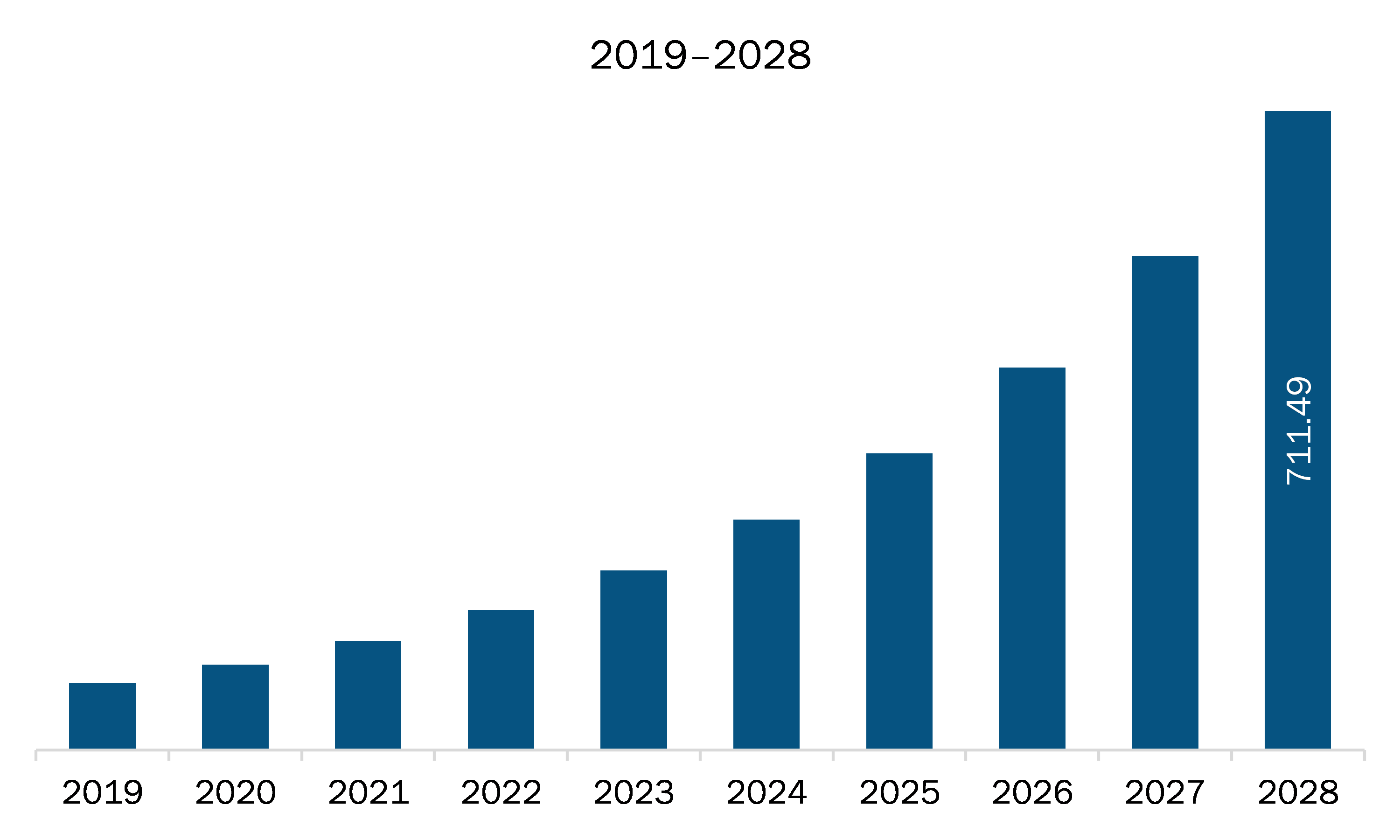The remote cardiac monitoring market in SCAM is expected to grow from US$ 121.66 million in 2021 to US$ 711.49 million by 2028; it is estimated to grow at a CAGR of 28.7% from 2021 to 2028.
Brazil and Argentina are major economies in SCAM. Continuous developments in telemedicine approach is the major factor driving the growth of the SCAM remote cardiac monitoring market. As defined by Office for the Advancement of Telehealth, telehealth comprises the use of telecommunications and information technologies to share information as well as to remotely provide clinical care, health education, public health, and administrative services. It has the potential to help transform healthcare systems, simultaneously reducing costs as well as boosting quality, patient-centeredness, and patient satisfaction. To successfully treat heart-related diseases, including CVDs, health professionals encourage patients to make lifestyle changes, continue a regular course of medication, and rigorously follow the follow-up schedule. However, despite the potential health benefits of regular doctor appointments and tests, clinic visits may act as an imposition on patients’ daily lives. As a result, disruptions in follow-up have become a common issue. Further, this situation has worsened with the pandemic. Clinic visits and elective procedures were suspended, and patients avoided visiting clinics due to the fear of SARS-CoV-2 infection. Telehealth helps health systems in overcoming a few of the systemic barriers in monitoring heart diseases and CVDs. Technological solutions address the challenges posed by physical distance and facilitate personal interactions between doctors and patients. The doctors can remotely monitor conditions that contribute to heart attack and stroke, providing an opportunity to implement primary and secondary cardiovascular prevention without asking patients to visit the clinics. Patients can get any tests done before the appointment at a lab close to their home; they can also measure their blood pressure with an automatic blood pressure cuff at home, local pharmacies, or senior centers. Telehealth appointments are more convenient than in-person clinic visits for both doctors and patients. The introduction of remote monitoring of health data using wireless devices that measure weight, blood pressure, blood sugar, pulse, and heart rhythm could further advance telehealth services. Moreover, the telemedicine approach uses remote patient monitoring systems or devices to keep a check on the health status of patients. Along with cardiac monitors, companies are also working on developing monitoring devices for hematology, including blood glucose monitors, and for respiratory diseases, including sleep apnea and respiratory rate monitors, which is further anticipated to drive the Remote Cardiac Monitoring market in SCAM.
Market participants and end users are losing their business due to the temporary closure of companies in different regions because of COVID-19 pandemic. The second wave of COVID-19 affected Brazil, Argentina, Uruguay, Chile, Peru, and Colombia, among which Brazil recorded the highest number of deaths. In this situation, there was discontinuation of physiotherapy and other related treatments. An adverse side effect of the lockdown restricted access to health system facilities, which impacted the treatment and management of acute and chronic cardiovascular diseases. Long before the COVID-19 pandemic changed people's lives, remote heart monitoring devices had emerged as a viable way to overcome the long intervals between doctor visits, remotely monitor patients, and protect them by preventing the progression of the disease recognized in time to prevent hospitalization. The onset of COVID-19 pandemic has further accelerated the demand for remote cardiac monitoring, which is subsequently driving its market.

- This FREE sample will include data analysis, ranging from market trends to estimates and forecasts.
SCAM Remote Cardiac Monitoring Market Segmentation
SCAM Remote Cardiac Monitoring Market – By Product Type
- Devices
- Vital Signs Monitors
- Heart Rate Monitors
- Blood Pressure Monitors
- Breath Monitors
- Holter Monitors
- Others
- Software
- Cloud Based Software
- On-Premise Software
- Services
SCAM Remote Cardiac Monitoring Market – By End User
- Hospitals and Clinics
- Emergency Settings
- Homecare Settings
- Others
SCAM Remote Cardiac Monitoring Market– By Country
- Brazil
- Argentina
- RoSCAM
SCAM Remote Cardiac Monitoring Market-Companies Mentioned
- Abbott
- Biotronik, Inc.
- Boston Scientific Corporation
- Honeywell International Inc.
- Koninklijke Philips N.V.
- Medtronic
- Nihon Kohden Corporation
- OSI Systems, Inc.
South and Central America Remote Cardiac Monitoring Report Scope
| Report Attribute | Details |
|---|---|
| Market size in 2021 | US$ 121.66 Million |
| Market Size by 2028 | US$ 711.49 Million |
| CAGR (2021 - 2028) | 28.7% |
| Historical Data | 2019-2020 |
| Forecast period | 2022-2028 |
| Segments Covered |
By Product Type
|
| Regions and Countries Covered |
South and Central America
|
| Market leaders and key company profiles |
|
- Historical Analysis (2 Years), Base Year, Forecast (7 Years) with CAGR
- PEST and SWOT Analysis
- Market Size Value / Volume - Regional, Country
- Industry and Competitive Landscape
- Excel Dataset
Recent Reports
Testimonials
Reason to Buy
- Informed Decision-Making
- Understanding Market Dynamics
- Competitive Analysis
- Identifying Emerging Markets
- Customer Insights
- Market Forecasts
- Risk Mitigation
- Boosting Operational Efficiency
- Strategic Planning
- Investment Justification
- Tracking Industry Innovations
- Aligning with Regulatory Trends






















 Get Free Sample For
Get Free Sample For